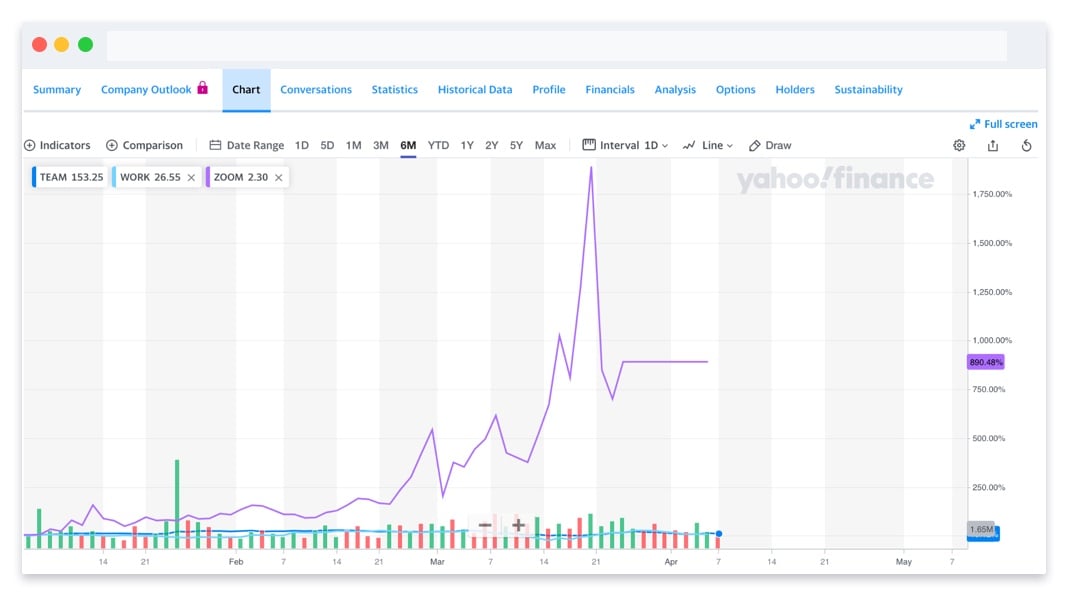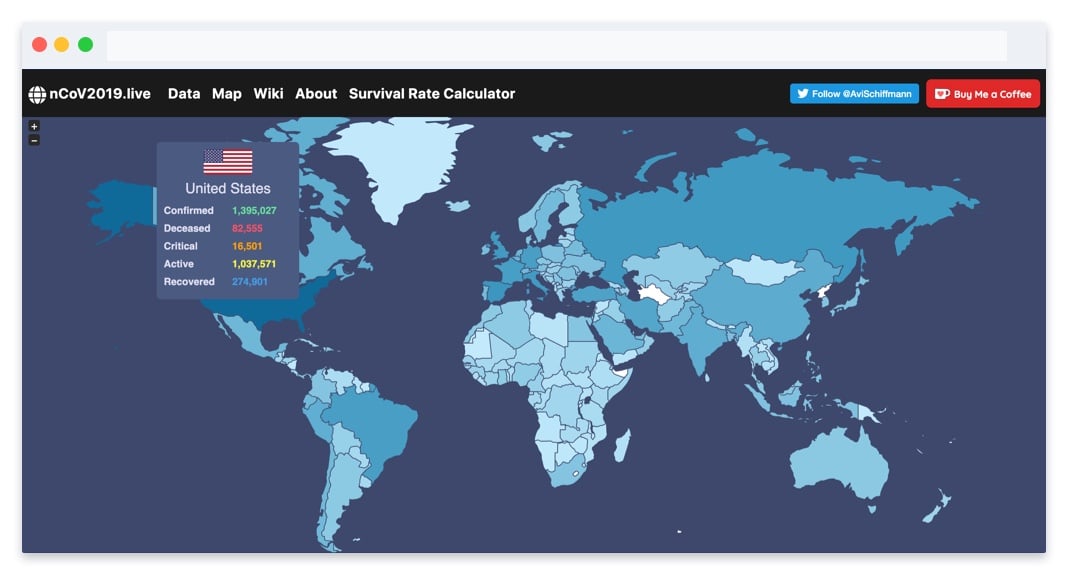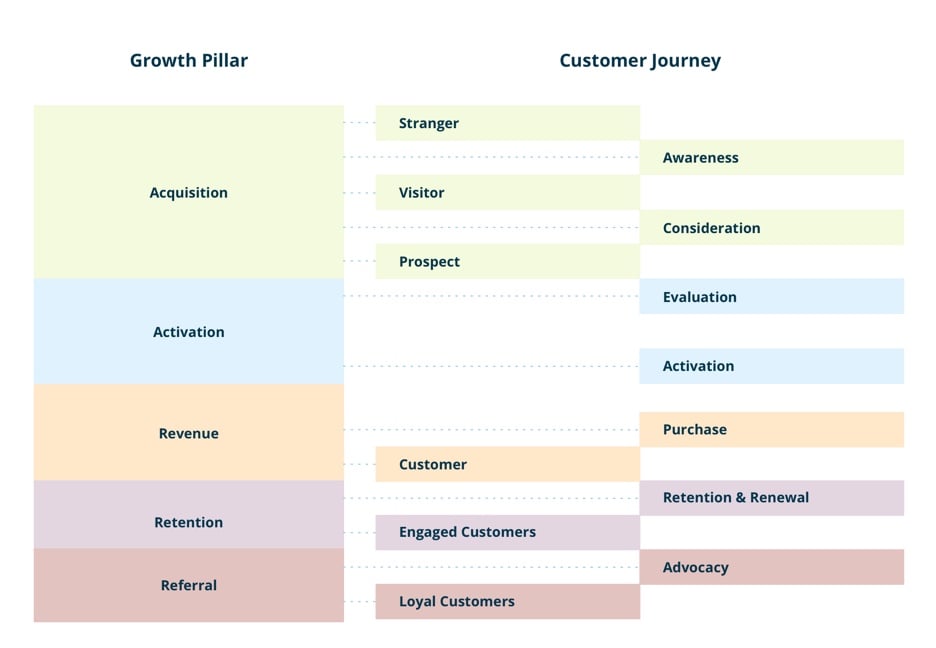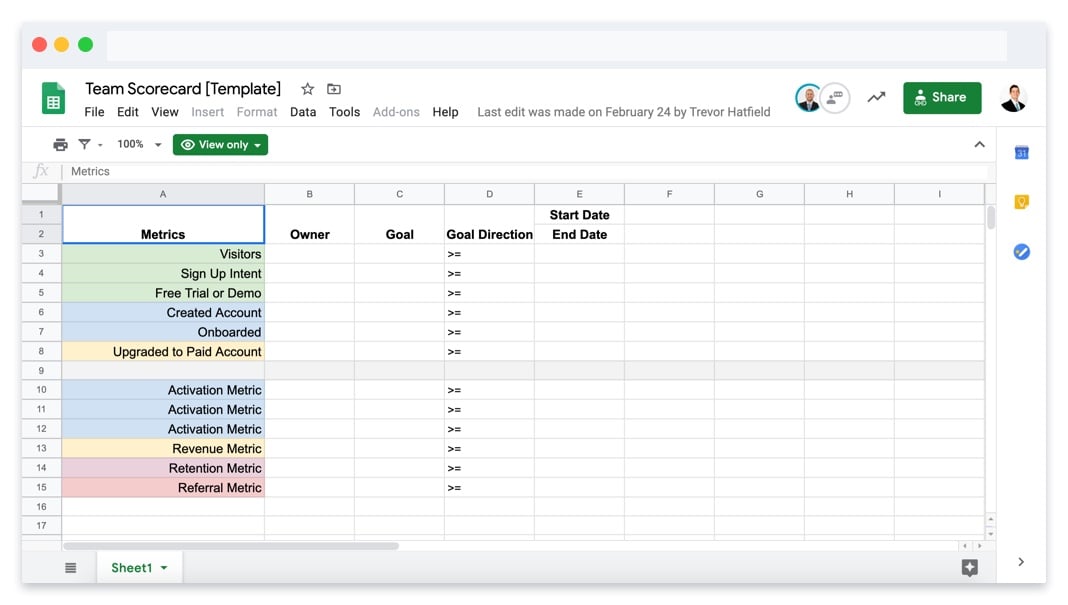
It’s no surprise to those familiar with Cloud computing; it has saved all of our butts. After all, what would we have done once the shelter-in-place order was issued if companies were still using email for collaboration and Microsoft office documents.
Imagine a world with no Zoom, no real-time document collaboration, no cloud-based storage.
Statistically speaking, the 2-hours of daily productivity that we typically achieve in office could have easily decreased to 2-hours a week without cloud-based solutions to fall back on, and from a business perspective that is a very scary thought.
As you can see below, it’s no wonder Zoom’s stock has shot straight up, even compared with other SaaS companies and there is a forecast that it will generate a higher Return on Assets (6.98%)

And as such, other tools like Slack and Atlassian have seen strong market indicators, not to mention the obvious ones like Amazon, GrubHub, Instacart, and DoorDash.
The New Norm
But this Bull Market SaaS bubble for these types of online collaboration software will not last forever. In a matter of months, we will all be rolling that proverbial rock away from our doors, smelling the fresh air, and wondering to ourselves, “Ok, now what?”
What is now ‘the new norm’ for many local businesses will become their status quo. For instance, my local board game shop, out of necessity, is now an eCommerce store. The tap house down the road takes text orders for growler refills. Don’t expect these new business delivery models to go away after quarantine. No. They will offer companies an additional revenue stream once their brick and mortar is back up and running.
With new usage comes new needs, new problems to solve and new software ideas, such as security, load-balancing, and other infrastructure. After all, hasn’t this crisis exacerbated the need for cloud-based solutions?
Mehdi Salour, senior vice president of network operations and devOps at 8x8, said:
“the number of new users for the 8x8 Video Meetings cloud service in February increased close to 100 percent month over month, with the total number of new users in 2020 already reaching more than double the amount since they launched.” (Source)
You might say that even consumers have come to expect these new forms of digital accommodation and thus will be even more open to hiring SaaS solutions in the coming months and years in place of traditional transactions. Thus we expect a huge surge in online software sales post Covid-19 across a variety of industries and use-cases.
Are You Ready for the Covid-19 Aftermath?
This is no joke. VC money is all but dried up for some. Large purchases have been put on hold until “the coast is clear”. We, at Inturact, have had leads delay the decision to sign with us until they were more sure of the markets and we’ve had current clients downgrade temporarily to preserve their runway. Sadly, we even had a client lose all of their promised VC cash infusion and in one day went from Growth to Survival.
But this will not last forever. Sure, Covid-19 is leaving plenty of long-lasting economic damage in its wake, but at some point, it will be back to business as usual. And when that happens, your competition will be hitting the streets hard. With the cost of advertising down to an all-time low (as of writing this, a single YouTube view is only $.10!) you better start looking past the work-at-home productivity issues and start planning for life after Covid-19 has passed.
What Can We Expect?
In early December last year (2019), a 17-year old “thought it would be cool if there was a website that could pull in all the information from all kinds of (sources),” (source) and so built a site that aggregates all the Covid-19 data from around the world into a clean and elegant display. You can see his work here, Covid Data Map. Self-taught, he built something that interested him, and four months later, his traffic is through the roof.
 If that’s the growth going into the Pandemic, what will the growth line look like going out of it? Consider his moment of fame is as long-lived as this pandemic is.
If that’s the growth going into the Pandemic, what will the growth line look like going out of it? Consider his moment of fame is as long-lived as this pandemic is.

Let’s just lay it out there.
We don’t know what happens after Covid but businesses should take a longer view and should not rely on pandemic news for sustained operations.
However, if you are seeing a bump, then try to retain as much of that bump as you can for as long as you can.
If you are getting hit right now, then most of your competitors are too, and if you have the means to push through you have an opening to get ahead of the competition like you have never had before.
Starting now, SaaS companies need to look past quarantine and develop a plan for re-entering the market place that takes advantage of, but is not exploitative of, the devastation of this virus.
Your Existing Customers are now More Important than Ever Before
The reason why investors love SaaS businesses is not that they’re great at acquiring new customers; it’s because they have access to data, unlike most businesses, that help them be great at keeping customers.
And as we’re sure you’ve heard, it’s astronomically cheaper to retain an existing customer than it is to get a new one. As Gainsight noted,
“Obtaining a new customer can be anywhere from five to 25 times more expensive than selling to existing customers” (source).
This is why it’s important to make sure you have clear metrics regarding business retention:
- Is your churn being tracked?
- Do you have exit interviews?
- Can you take steps to surprise and delight customers to increase brand loyalty?
Increasing Retention via Tracking Your Customer Engagement Churn Rate
A huge part of retention is truly understanding customer engagement and how to identify growth opportunities from tracking it. One aspect of this is knowing your customer engagement churn rate. Most companies track customer (logo) churn and revenue churn, however, they don’t track customer engagement churn.
What is Customer Engagement Churn?
To answer this, we must first understand customer engagement. Every SaaS product has a set of events or actions that a customer takes within their product that are the most important actions. We call these Actionable Metrics, learn more about these here.
Defining and tracking these actions, in particular retention metrics, are vital in understanding how engaged each of your customers are with your product. To learn more about defining your actionable metrics, check out this video on tracking the metrics that matter most for your SaaS business.
Once you agree on your actionable retention metrics and they are being tracked, you can now know the moment a customer’s usage of these mission critical events drop. At this point you have what we define as Customer Engagement Churn.
Oftentimes this indicator happens months before a customer even considers cancelling their account.
Just imagine what you can do with this data!
By proactively addressing engagement churn through properly defining and tracking your actionable retention metrics, also known as customer engagement analytics, you can put in place strategic marketing and customer success tactics to address customer concerns before they churn, thus increasing retention and even potentially opening the door for additional expansion revenue.
Get help defining your companies Actionable Metrics
Bandwidth Preservation and Alternative Forms of Distribution
According to ZDNet,
“Traffic prioritization and shaping need to be put in place for core business applications during prime hours, which includes video conferencing for business and personal use. This would effectively be the opposite of net neutrality, as an emergency measure.” (Source)
New software is going to have to use less memory and optimize for processing power and bandwidth. Since the pandemic, every conference call we’ve experienced has been interrupted by poor bandwidth whether that’s in ISP themselves or our kids watching Netflix on three different devices in our house. Note: Netflix is actually throttling video quality in Europe because of this.
Previously the game was to use as much bandwidth as possible without sacrificing user experience. Now, consumer expectations are, “Let’s just get the job done without crashing.”
As such, any innovations around Infrastructure, cloud computing, CDN or load balancing are going to become important post Covid-19.
Business Productivity: Moving Away from Mobile Computing
Since there is far less commuting and certainly there will be more people working from home after this, making sure your app works just as well on mobile devices is less important.
Personally, I don’t have a commute, so I don’t listen to podcasts very much as I’m not stuck in traffic and I no longer need to rely on my phone for Slack when out and about since I’m now never more than 5 steps from my laptop.
Thinking forward, there may be a bit of a transition back to desktop. You may look at focusing less on your mobile experience for a bit and more on making sure your desktop experience is as compatible as possible. There are a lot of people now working from home on their old laptops with old operating systems.
New Privacy and Security Concerns
When everyone is at home, there’s not much need for apps that track your location, nor is there as much concern about the security of that private information. There are no traffic jams to avoid, and there are no teenagers to track down (You hope!).
New systems are already getting developed to optimize the movement of goods and services to you, rather than the other way around. So the question is no longer, “Can I get there in time” but rather, “How long until my stuff arrives.” In Rhode Island, for example, there is currently (at the time of this writing), a three-week wait to get your groceries delivered. (Source)
My wife works in healthcare administration. She goes to the office everyday, wears a mask at her desk and goes through temperature checks to enter the building. This is great in theory, but since she’s not patient-facing, why can’t she work from home?
Five letters: HIPPA. There’s no way to ensure that a home-station would not be compromised by the snooping eyes of her husband.
Patient health data is sacred and fines for breaking HIPPA are extreme but ultimately unenforceable when removed from a clinical setting. Other sensitive industries are similarly afflicted, where the health and safety of the worker comes second to the security policies currently enforced.
What’s happening with face recognition and digital identity right now that could solve this?
To make matters even more complicated, companies that are thriving now, like Zoom, are coming under increased scrutiny with regards to how they are protecting user data. As we know, unless you’ve been under a rock, Zoom is being sued for just this violation. With more people buying things online, that data is massive and potentially very valuable, however, if not secured, could become a source of fraud and other security issues.
 One final and dangerous word about security… Now, more than ever before, misinformation is dangerous and life-threatening. When my mom had a Covid-19 scare and was showing symptoms, she said, “Oh I’ll drink some hot water. Hot water kills the virus.” She read this online and was literally about to put her life in the hands of a bogus fake-news post. In the end, she luckily tested negative, but it makes you think of all the thousands of people who may have believed this claim.
One final and dangerous word about security… Now, more than ever before, misinformation is dangerous and life-threatening. When my mom had a Covid-19 scare and was showing symptoms, she said, “Oh I’ll drink some hot water. Hot water kills the virus.” She read this online and was literally about to put her life in the hands of a bogus fake-news post. In the end, she luckily tested negative, but it makes you think of all the thousands of people who may have believed this claim.
Some Domain Name services are taking a leadership role in removing websites promoting non-scientific news about the virus. And on this topic, Facebook has remained alarmingly quiet.
Have we finally come to understand that there actually is a reality and truth can’t be made up?
What software services can come into play to solve this problem?
Bridging the Gap Between Online and Offline
Restaurants and food distribution companies are reshuffling how they reach customers with a focus on adapting to new trends and technologies such as restaurant menu templates. Food-prep, online food shopping and delivery are all being reimagined. Healthy options like vegan and keto-friendly meal delivery are going to take precedence more than ever and companies need to work with their carriers more closely to ensure a good customer experience.
“With as many as 75% of all restaurants having to close due to economic losses incurred from the Covid-19 crisis, it may be necessary or more efficient to have a centralized or a consolidated distribution of food and other goods in major population centers.” (Source)
Using Data to Make Smarter Marketing Decisions
What data do you need in order to make the best marketing decisions for your business?
We’ve made some market projections here, which we hope are helpful, but when it comes to getting your SaaS business back on its feet, you’ll need to make sure you are making data-backed decisions. Otherwise, you run the risk of making emotional decisions or decisions based on an out-dated pre-pandemic paradigm.
Here is a basic breakdown of the most important areas to consider to give you a head start:
Define the Most Important Metrics to Track
Start by determining the most important metrics to track for your particular business and you will set the building blocks to having total team alignment. Again, have a look at our Actionable Metrics framework to kick this off.
Assign Team Responsibility
Take team alignment one step further with deeper accountability. Determine the teams (Sales, Marketing, Customer Success, etc.) responsible for growing each metric as well as an individual owner responsible for determining if the metric is on track or not. Build a Team Scorecard to review on your weekly or monthly team calls.
Here is a free Team Scorecard template to get you started.
Understand the 3 Vital Types of Tracking
At Inturact we breakdown tracking into 3 primary areas:
Accountability Tracking
We just discussed what we call Accountability Tracking. Holding your team accountable for growing the actionable metrics
Dashboard Tracking
This is the most common type of tracking everyone already knows. These are dashboards built with BI Tools or Excel sheets that keep a high-level pulse on your business. Generally, if someone discovers a downward trend in a metric or new issue within a dashboard they try to determine a test or opportunity. However, we suggest taking this one step further with Opportunity Tracking. You can find high level opportunities within Dashboard Tracking but to determine a true test you need to dig deeper into the data.
Opportunity Tracking
This is where you work to discover deep insights within your user analytics to pinpoint the highest opportunities for growth and work to resolve issues faster. Most companies put this task on their data scientist. However, we suggest checking out a tool called InnerTrends which puts the power of a data scientist into a product manager's hands without having to be one!
We will be writing a more detailed article on this soon. In the meantime learn more about these types of tracking by scheduling a SaaS consultation with an Inturact growth expert.
Determine the Right SaaS Metrics to Track & Revenue Goals
What other important SaaS metrics do we need to track that will help us identify how the business is growing? For example, we need a channel CAC goal in order to make sure our marketing channels are producing, the unit economics are making sense and we are growing in a healthy way.
Important example metrics that we will need include but are not limited to:
- Revenue Goal
- CAC (Overall and by Channel)
- Churn
- LTV
- LTV:CAC Ratio
Finally, determine the best strategies to grow.
What strategies make the most sense to grow your product based on all of the data research we have done so far?
At Inturact, we breakdown our focus areas from the top down starting with what we call our Growth Pillars which align with the customer journey like this:

We suggest paying close attention to the metrics and strategies surrounding Activation, Retention and Referral in the coming months as:
- Churn increases
- Revenue decreases
- Burn rate increases and runway becomes a bigger focus
For help in any of these areas in order to get ahead during this pandemic as well as afterwards we would love to chat about how we can help.
Schedule a call with a growth expert to talk about how Covid has affected your business and how Inturact can help.
References:
https://asiatimes.com/2020/04/pandemic-opens-curtains-on-next-economic-model/
https://techcrunch.com/2020/03/23/stocks-broadly-fall-as-nasdaq-dips-modestly-saas-gains-on-the-day/
https://www.zdnet.com/article/the-future-of-the-technology-industry-after-covid-19/
https://seekingalpha.com/article/4332955-case-for-cloud-saas-amid-market-turmoil



